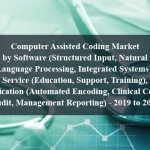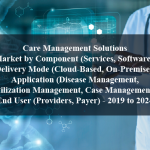OVERVIEW
The Healthcare Asset Management Market is currently valued at USD 11,002.50 million in 2024 and will be growing at a CAGR of 25.3% over the forecast period to reach an estimated USD 215,133.5 million in revenue in 2029. The healthcare asset management market is witnessing significant growth propelled by the increasing adoption of asset management solutions in healthcare facilities worldwide. These solutions offer efficient tracking and management of medical equipment, devices, and other assets, ensuring their optimal utilization, maintenance, and regulatory compliance. Key factors driving market expansion include the rising need to curb healthcare operational costs, enhance patient safety, and streamline workflow efficiency. Moreover, technological advancements such as RFID, IoT, and cloud-based platforms are revolutionizing asset management practices in healthcare, enabling real-time asset tracking, inventory management, and predictive maintenance. With healthcare organizations increasingly prioritizing asset optimization to deliver high-quality patient care amidst cost constraints, the healthcare asset management market is poised for continuous growth and innovation.
The increasing emphasis on cost reduction and operational efficiency in healthcare facilities is propelling the adoption of asset management solutions. By efficiently tracking and managing assets such as medical equipment and devices, healthcare organizations can minimize waste, improve resource allocation, and streamline workflows, ultimately leading to cost savings. Additionally, the growing focus on patient safety and regulatory compliance is driving the demand for asset management solutions that ensure the proper maintenance and utilization of critical assets. Moreover, technological advancements such as RFID, IoT, and cloud-based platforms are enhancing the capabilities of asset management systems, enabling real-time tracking, automated inventory management, and predictive maintenance. As healthcare providers continue to prioritize asset optimization to deliver high-quality care and remain competitive, the healthcare asset management market is expected to experience sustained growth.
Market Dynamics
Drivers:
The increasing emphasis on cost reduction and operational efficiency in healthcare facilities is propelling the adoption of asset management solutions. By efficiently tracking and managing assets such as medical equipment and devices, healthcare organizations can minimize waste, improve resource allocation, and streamline workflows, ultimately leading to cost savings. Additionally, the growing focus on patient safety and regulatory compliance is driving the demand for asset management solutions that ensure the proper maintenance and utilization of critical assets. Moreover, technological advancements such as RFID, IoT, and cloud-based platforms are enhancing the capabilities of asset management systems, enabling real-time tracking, automated inventory management, and predictive maintenance. As healthcare providers continue to prioritize asset optimization to deliver high-quality care and remain competitive, the healthcare asset management market is expected to experience sustained growth.
Key Opportunities:
The healthcare asset management market presents several key opportunities for growth and innovation. One significant opportunity lies in the integration of advanced technologies such as artificial intelligence (AI), machine learning (ML), and big data analytics into asset management solutions. These technologies can enable predictive maintenance, anomaly detection, and data-driven insights, helping healthcare organizations optimize asset utilization, minimize downtime, and enhance operational efficiency. Furthermore, the increasing adoption of telehealth and remote monitoring solutions presents opportunities for the expansion of asset management into virtual care settings, where tracking and managing assets across multiple locations and devices become paramount. Additionally, the rising trend of value-based care and outcome-driven models emphasizes the importance of leveraging asset management solutions to improve patient outcomes, reduce readmission rates, and enhance overall healthcare delivery. By capitalizing on these opportunities and leveraging innovative technologies, healthcare asset management providers can drive greater value for healthcare organizations and stakeholders while fostering continuous advancements in the field.
Restraints :
One notable restraint is the high initial investment required for implementing asset management solutions, including hardware, software, and infrastructure costs. This financial barrier can deter adoption, particularly for smaller healthcare facilities with limited budgets. Additionally, interoperability challenges among different asset management systems and legacy IT infrastructure within healthcare organizations can hinder seamless integration and data sharing, limiting the effectiveness of asset management initiatives. Moreover, concerns around data security and privacy compliance pose significant barriers, especially with the sensitive nature of patient information stored and managed within asset management systems. Regulatory requirements such as HIPAA in the United States and GDPR in Europe further compound these challenges, necessitating robust security measures and compliance frameworks. Addressing these restraints will require collaboration among stakeholders, investment in interoperable technologies, and a concerted effort to prioritize data security and privacy in healthcare asset management strategies.
Regional Information:
• In North America, the healthcare asset management market is witnessing robust growth driven by the region’s advanced healthcare infrastructure and the adoption of innovative technologies. The presence of major healthcare players, coupled with strong government initiatives aimed at improving healthcare quality and efficiency, further fuels market expansion. In the United States, particularly, the implementation of regulations such as the Affordable Care Act and the increasing focus on value-based care models are driving the demand for asset management solutions to optimize resource utilization and enhance patient outcomes.
• In Europe, the healthcare asset management market is experiencing steady growth supported by the region’s aging population and the need to modernize healthcare infrastructure. Countries like Germany, France, and the United Kingdom are at the forefront of adopting asset management solutions to address challenges such as rising healthcare costs and the need for improved operational efficiency. Additionally, stringent regulatory frameworks, particularly regarding patient data protection and privacy under GDPR, are influencing market dynamics and driving investments in secure and compliant asset management technologies.
• In the Asia Pacific region, the healthcare asset management market is rapidly expanding due to increasing healthcare spending, growing investments in healthcare infrastructure, and the adoption of digital health solutions. Countries such as China, India, and Japan are witnessing significant demand for asset management solutions to address challenges related to healthcare resource management, patient safety, and regulatory compliance. Moreover, the proliferation of mobile health technologies and the rise of smart hospitals are driving the adoption of asset management solutions to enable seamless tracking and management of medical equipment and devices across healthcare facilities in the region.
Recent Developments:
• March 2022 – Crothall Healthcare’s Healthcare Technology Solutions (HTS) division acquired ABM’s clinical engineering organization. Whereas The Clinical Engineering group of ABM will be under the control of Crothall’s Healthcare Technology Solution business, which will use its knowledge and expertise to enhance operations, as the entire lifecycle of medical devices in a hospital is managed and overseen by Crothall Healthcare.
• March 2022 – Sodexo teamed up with University Hospitals to offer comprehensive primary care and community-based services. Sodexo aimed to provide a range of services under this arrangement, including resource and construction management, technical control over healthcare, patient diet, retail food, and management of resources.
Key Market layers:
CenTrak, IBM Corporation, GE Healthcare, Siemens Healthineers, Zebra Technologies Corporation, Stanley Healthcare, Honeywell International Inc., Airista Flow Inc., Ekahau Inc., and Awarepoint Corporation.
Frequently Asked Questions
1) What is the projected market value of the Healthcare Asset Management Market?
– The Healthcare Asset Management Market is expected to reach an estimated value of USD 215,133.5 million in revenue by 2029.
2) What is the estimated CAGR of the Healthcare Asset Management Market over the 2024 to 2029 forecast period?
– The CAGR is estimated to be 25.3% for the Healthcare Asset Management Market over the 2024 to 2029.
3) Who are the key players in the Healthcare Asset Management Market?
– CenTrak, IBM Corporation, GE Healthcare, Siemens Healthineers, Zebra Technologies Corporation, Stanley Healthcare, Honeywell International Inc., Airista Flow Inc., Ekahau Inc., and Awarepoint Corporation.
4) What are the drivers for the Healthcare Asset Management Market?
– The healthcare asset management market is experiencing sustained growth due to the growing focus on cost reduction, operational efficiency, patient safety, and regulatory compliance. Technological advancements like RFID, IoT, and cloud-based platforms are enhancing asset management systems, enabling real-time tracking, automated inventory management, and predictive maintenance.
5) What are the restraints and challenges in the Healthcare Asset Management Market?
– High initial investment in asset management solutions can deter adoption, especially for smaller healthcare facilities. Interoperability challenges, data security concerns, and regulatory requirements like HIPAA and GDPR further complicate the process. Addressing these restraints requires collaboration, investment in interoperable technologies, and prioritizing data security and privacy in healthcare asset management strategies.
6) What are the key applications and offerings of the Healthcare Asset Management Market?
– Key applications of healthcare asset management include inventory tracking and management of medical equipment and supplies, ensuring regulatory compliance and patient safety, optimizing asset utilization to reduce operational costs, and enabling predictive maintenance and lifecycle management of healthcare assets to improve efficiency and reliability.
7) Which region is expected to drive the market for the forecast period?
– North America is expected to have the highest market growth from 2024 to 2029
Why Choose Us?
Insights into Market Trends: Global Market Studies reports provide valuable insights into market trends, including market size, segmentation, growth drivers, and market dynamics. This information helps clients make strategic decisions, such as product development, market positioning, and marketing strategies.
Competitor Analysis: Our reports provide detailed information about competitors, including their market share, product offerings, pricing, and competitive strategies. This data can be used to inform competitive strategies and to identify opportunities for growth and expansion.
Industry Forecasts: Our reports provide industry forecasts, which will inform your business strategies, such as investment decisions, production planning, and workforce planning. These forecasts can help you to prepare for future trends and to take advantage of growth opportunities.
Access to Industry Experts: Our solutions include contributions from industry experts, including analysts, consultants, and subject matter experts. This access to expert insights can be valuable for you to understand the market.
Time and Cost Savings: Our team at Global Market Studies can save you time and reduce the cost of conducting market research by providing comprehensive and up-to-date information in a single report, avoiding the need for additional market research efforts.












